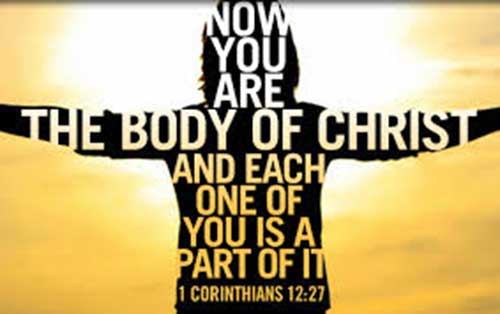Principle 3: The church at prayer is Christ in his Body at prayer
The third principle, above, comes from Celebrating the Eucharist by Patrick Malloy (The first principle is here, the second principle is here).
In the liturgy, the church enters consciously and intentionally into the prayer that Christ offers ceaselessly before God. The liturgy, then, is not a matter of some people watching others do sacred things, but of the entire assembly being caught up in a sacred and eternal event….It is an actual participation in the liturgy of heaven… We are giving our voices and our bodies to Christ so that he might pray his eternal prayer before God “on earth as it is in heaven.”
Once again, this principle undergirds so much of my book, Celebrating Eucharist; the discussions on this site focusing on the two great prayers: the collect and the eucharistic prayer – in Christ, in the power of the Spirit, offered to God the Source of all Being; and the efforts with making the worship environment enhance the sense of participation rather than spectating.
Principle 1: The entire assembly celebrates the liturgy
Principle 2: Actions are Prayer




I’m currently away from Canada for a couple of weeks, visiting the UK for some academic work, and it’s been great to experience the one-ness of the Body of Christ bridging the distance between my Canadian parish and my C. of E. brothers and sisters, especially in worship. I’ve only attended a few liturgies so far (looking forward to more), but each has felt at once intensely vivid and “full homely”: an early Holy Communion in York Minster, said Evening Prayer in St Botolph’s, Cambridge (a jewel of a church); and this evening, the full works Festal Evensong at King’s College, Cambridge (my old choir!) for St John the Baptist.
That last one was a chance to put the “Actions are Prayer” principle into practice. It’s graduation tomorrow, so even this huge chapel was full: packed with (normally heathen) students and their proud parents. Not a seat to be had in the quire (never mind the Tudor stalls usually reserved for College members). So I opted for the second-best seat in the house: the stone benches in the West wall, as far away from the “action” as you can get, and about fifty miles from intelligibility. But I could stand as the choir entered; sign myself at “O Lord, open thou our lips”, “O God, make speed to save us”, the canticles and the creed; stand for the psalms, sit for the lessons; and bow profoundly at the doxologies and the prayers; all the while reflecting on the Baptist.
It was a powerful experience of corporate prayer entirely removed from verbal concentration (though it helped to have the most glorious music washing over me, and to know most of the texts by heart anyway — not to mention that rather exceptional “worship environment”). I felt fully united to the liturgical action of the whole congregation.
Travel is a great help for someone like me who can sometimes find it hard to feel tangibly part of the One Body.
One of the prayers offered at the OFFERTORIUM, at the co-mixture of wine and water, worth remembering, is this:
“By the mystery of this water and wine, may we come to share in the divinity of Christ, who humbled Himself to share in our humanity”.
For me, this encapsulates our intention to be joined with Jesus Christ; crucified, risen and glorified in the action of the Eucharist.